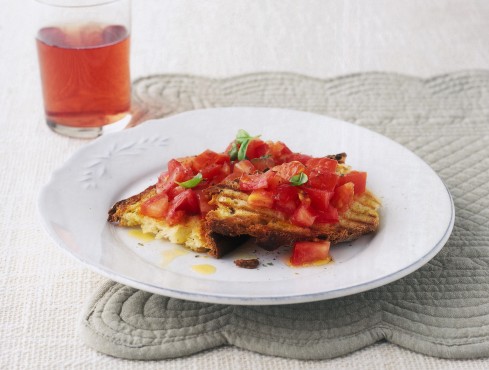
ITALIAN BRUSCHETTA
The word “bruschetta” has its origins in central Italy, and it is a slice of toasted bread.
It is believed that this poor man’s food was born as a snack for sharecroppers and farmers working in the fields; It was prepared with homemade, sometimes stale, bread and flavoured with olive oil, garlic, salt, pepper, and tomato. These are the basic ingredients of bruschetta. However, today the ways to prepare it and variations in circulation are truly endless.
For proper preparation of bruschetta, it is necessary to slightly grill the surface of the bread, taking care that it remains soft inside. Tuscan bread, with its large loaf and often square form, lends itself particularly well because it can be easily cut into slices.
The slices for a bruschetta should be fairly thick, surrounded by a quite hard but crunchy crust, with a soft, white crumb, and small and regular cavities (suitable to absorb the oil). These, once grilled, although well seasoned with oil, will be stiff and easily manageable. It is a bread that stays good for a long time and so it is ideal to be used to prepare this dish, even if it is not freshly baked. If you consider that in the past, especially in very poor rural areas of Italy, often one had little more than this, it is understandable how bruschetta often became a full dinner and not just a snack or appetizer.
Bruschetta seasoning – Bruschetta ingredients
Let’s talk about garlic. Remember that is absolutely forbidden to overuse it. One clove is enough for more than one slice and according to Tuscan custom, you just pass it on the borders of the warm bread. So the garlic should not be used as a cream or powder, as is often the US habit.
Bruschetta’s main seasoning is a very good extra virgin olive oil. Any lesser quality oil is not suitable. With this said, the bruschetta cost is really low, as the basic ingredients are just olive oil, salt, tomato, basil, and garlic (not necessary). However, if you want to create a bruschetta duet or bruschetta trio for serving and you choose some more interesting recipes, obviously the bruschetta cost will go up.
Remember that if you use too much garlic you risk covering the aroma and fragrance of the oil you have used. The breadcrumb should be oiled well, but not dripping wet and it should be seasoned with a pinch of salt and pepper to enhance aroma and flavour. The same remark about garlic goes also for the other ingredients – less is more.
The various “innovations”, from anchovies with capers, cheese, and flavourful sauce, are to be added in quantities that give flavour and colour, but not in doses that will cover any other flavouring. You certainly have seen some “creative” bruschettas with huge amounts of various ingredients.
Normally, the unfortunate consumer does not know how to take a bite off of a very big bruschetta. They begin to eat the bruschetta and in the meanwhile, the ingredients start to slip everywhere. They try to stem the fall with a napkin, and in the meanwhile, the oil and tomatoes are smeared on the other hand; or if the bruschetta is not too large, they try to open their mouth as much as possible and eat it in one bite. A real disaster! So the golden rule is simplicity. Instead of using a thousand ingredients altogether, maybe it is better to prepare some more bruschettas, each one different from the other one.
Adapted from https://lifeinitaly.com/bruschetta/